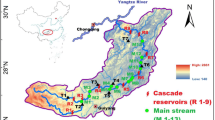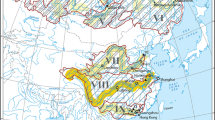Abstract
Reservoir construction within a basin affects the process of water and sediment transport downstream of the dam. The Three Gorges Reservoir (TGR) affects the sediment transport downstream of the dam. The impoundment of the TGR reduced total downstream sediment. The sediment group d≤0.125 mm (fine particle) increased along the path, but the average was still below what existed before the reservoir impoundment. The sediments group d>0.125 mm (coarse particle) was recharged in the Yichang to Jianli reach, but showed a deposition trend downstream of Jianli. The coarse sediment in the Yichang to Jianli section in 2003 to 2007 was above the value before the TGR impoundment. However, the increase of both coarse and fine sediments in 2008 to 2014 was less than that in 2003 to 2007. The sediment retained in the dam is the major reason for the sediment reduction downstream. However, the retention in different river reaches is affected by riverbed coarsening, discharge, flow process, and conditions of lake functioning and recharging from the tributaries. The main conclusions derived from our study are as follows: 1) The riverbed in the Yichang to Shashi section was relatively coarse, thereby limiting the supply of fine and coarse sediments. The fine sediment supply was mainly controlled by TGR discharge, whereas the coarse sediment supply was controlled by the duration of high flow and its magnitude. 2) The supply of both coarse and fine sediments in the Shashi to Jianli section was controlled by the amount of total discharge. The sediment supply from the riverbed was higher in flood years than that in the dry years. The coarse sediment tended to deposit, and the deposition in the dry years was larger than that in the flood years. 3) The feeding of the fine sediment in the Luoshan to Hankou section was mainly from the riverbed. The supply in 2008 to 2014 was more than that in 2003 to 2007. Around 2010, the coarse sediments transited from depositing to scouring that was probably caused by the increased duration of high flow days. 4) Fine sediments appeared to be deposited in large amounts in the Hankou to Jiujiang section. The coarse sediment was fed by the riverbed scouring, and much more coarse sediments were recharged from the riverbed in the flood years than in the dry years. 5) In the Jiujiang to Datong section, the ratio of fine sediments from the Poyang Lake and that from the riverbed was 1: 2.82. The sediment from the riverbed scouring contributed more to the coarse sediment transportation. The contribution was mainly affected by the input by magnitude and duration of high flows.
Similar content being viewed by others
References
Benn P C, Erskine W D (1994). Complex channel response to flow regulation: Cudgegong River below Windermere Dam, Australia. Appl Geogr, 14(2): 153–168
Chen F, Li Y T (2009). Analysis of the characters of erosion and deposition downstream from the reservoir. In: Zhang C K, Tang H W, eds. Advances in Water Resources and Hydraulic Engineering. Springer Berlin Heidelberg, 797–802
Chen J G, Zhou W H, Yuan Y P (2002). Transportation and adjustment of different grain sized sediment along the lower Yellow River under typical operation modes of Sanmenxia reservoir. J Sediment Res, (2): 15–22 (in Chinese)
Dai Z J, Chu A, Stive M, Du J Z, Li J F (2011). Is the Three Gorges Dam the cause behind the extremely low suspended sediment discharge into the Yangtze (Changjiang) Estuary of 2006? Hydrol Sci J, 56(7): 1280–1288
Ge H, Zhu L L, Zhang X B (2011). Analysis of no uniform sediment recovery coefficient downstream from reservoir. Engineering Journal of Wuhan University, 44(6): 711–715 (in Chinese)
Guo X H, Li Y T, Qu G, Liu X Y (2014). Analysis of sediment transport in Middle Yangtze River after filling of the Three Gorges Reservoir. J Sediment Res, (5): 11–17 (in Chinese)
Han J Q (2015). The interaction mechanism between longitudinal water and sediment transport and channel morphology in the downstream of Three Gorges Reservoir. Dissertation for PhD. degree. Wuhan University (in Chinese)
Hydrology Bureau, Changjiang Water Resource Commission (HBCWRC) (2002). Analysis of river bed erosion downstream from Danjiangkou reservoir in period of retardation and period of water impoundment. Sediment Research of Three Gorge Project (Vol.7). Beijing: Intellectual Property Press, 75–82 (in Chinese)
Jiang L Z, Ban X, Wang X L, Cai X B (2014). Assessment of hydrologic alterations caused by the Three Gorges Dam in the middle and lower reaches of Yangtze River, China. Water, 6(5): 1419–1434
Li Q F, Yu M X, Lu G B, Cai T, Bai X, Xia Z Q (2011). Impacts of the Gezhouba and Three Gorges Reservoirs on the sediment regime in the Yangtze River, China. J Hydrol (Amst), 403(3–4): 224–233
Li Y T, Sun Z H, Deng J Y (2003). A study on riverbed erosion downstream from the Three Gorges Reservoir. Journal of Basic Science and Engineering, 11(3): 283–295 (in Chinese)
Liu C, Sui J Y, He Y, Hirshfield F (2013). Changes in runoff and sediment load from major Chinese rivers to the Pacific Ocean over the period 1955–2010. Int J Sediment Res, 28(4): 486–495
Luo X X, Yang S L, Zhang J (2012). The impact of the Three Gorges Dam on the downstream distribution and texture of sediments along the middle and lower Yangtze River (Changjiang) and its estuary and subsequent sediment dispersal in the East China Sea. Geomorphology, 179(1): 126–140
Wang H J, Yang Z S, Wang Y, Saito Y, Liu J P (2008). Reconstruction of sediment flux from the Changjiang (Yangtze River) to the sea since the 1860s. J Hydrol (Amst), 349(3–4): 318–332
Xu J X, Hu C H, Chen J G (2009). Effect of suspended sediment grain size on channel sedimentation in the lower Yellow River and some implications. Science in China Series E: Technological Sciences, 52 (8): 2330–2339
Yang S L, Xu K H, Milliman J D, Yang H F, Wu C S (2015a). Decline of Yangtze River water and sediment discharge: impact from natural and anthropogenic changes. Sci Rep, 5(1): 12581
Yang Y P, Deng J Y, Zhang M J, Li Y T, Liu W L (2015b). The synchronicity and difference in the change of suspended sediment concentration in the Yangtze River Estuary. J Geogr Sci, 25(4): 399–416
Yang Y P, Li Y T, Sun Z H, Fan Y Y (2014). Suspended sediment load in the turbidity maximum zone at the Yangtze River Estuary: the trends and causes. J Geogr Sci, 24(1): 129–142
Yang Y P, Zhang M J, Li Y T, Zhang W (2015c). The variations of suspended sediment concentration in Yangtze River Estuary. J Hydrodynam, 27(6): 845–856
Yang Y P, Zhang M J, Li Y T, Zhang W, You X Y, Zhu L L, Wang D (2016). Suspended sediment recovery and bedsand compensation mechanisn sffected by the Three Gorges Project. Acta Geogr Sin, 71 (7): 1241–1254 (in Chinese)
Zhang W, Yang Y P, ZhangMJ, Li Y, Zhu L L, You X Y, Wang D, Xu J F (2017). Mechanisms of suspended sediment restoration and bed level compensation in downstream reaches of the Three Gorges Project (TGP). J Geogr Sci, 27(4): 463–480
Zhao G S, Lu J Y, Visser P J (2015). Fluvial river regime in disturbed river systems: a case study of evolution of the Middle Yangtze River in Post-TGD (Three Gorges Dam), China. Journal of Geology & Geophysics, 4(6): 1–4
Zhu L L, Ge H, Li Y, Zhang W (2015). Branching Channels in the Middle Yangtze River, China. Journal of Basic Science and Engineering, 23(2): 246–258 (in Chinese)
Zhu L L, Ge H, Zhang X B, Li Y T (2012). Preliminary study on responses of non-uniform sediment scouring and silting in the middle Yangtze to its inflows. Journal of Hydroelectric Engineering, 30(6): 215–221 (in Chinese)
Acknowledgments
This research was supported by the National Key Research and Development Program of China (Nos. 2016YFC0402106 and 2016YFC0402301), State Key Laboratory of Hydraulic Engineering Simulation and Safety (Tianjin University) (No. HESS1719), the National Natural Science Foundation of China (Grant Nos. 51579123 and 51339001), Fundamental Research Funds for Central Welfare Research Institutes (Nos. TKS160103 and TKS140102), National Key Research & Development Programs (No. 2013BAB12B01), and Tianjin Natural Science Foundation of China (Nos. 15JCYBJC21900, 15JCQNJC07900, and 16YFXTSF00280).
Author information
Authors and Affiliations
Corresponding author
Rights and permissions
About this article
Cite this article
Li, S., Yang, Y., Zhang, M. et al. Coarse and fine sediment transportation patterns and causes downstream of the Three Gorges Dam. Front. Earth Sci. 12, 750–764 (2018). https://doi.org/10.1007/s11707-017-0670-z
Received:
Accepted:
Published:
Issue Date:
DOI: https://doi.org/10.1007/s11707-017-0670-z




